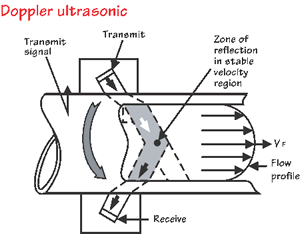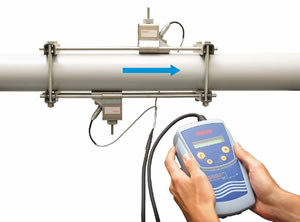Ultrasonic Flow Meters
Ultrasonic Flow Meter is a type of flow meter that measures the velocity of a liquid or gas by using the principle of ultrasound. Using ultrasonic transducers, the flow meter can measure the average velocity along the path of an emitted beam of ultrasound, by averaging the difference in measured transit time between the pulses of ultrasound propagating into and against the direction of the flow. Ultrasonic flow meters are affected by the temperature, density and viscosity of the flowing medium. They are inexpensive to use and maintain because they do not use moving parts, unlike mechanical Flow Meters.
Means of operation
There are three different types of ultrasonic flow meters. Transmission flow meters can be distinguished into in-line and clamp-on varieties. Ultrasonic flow meters that use the doppler shift are called reflection or doppler flow meters. The third type is the open-channel flow meter.
Doppler shift flow meters
Another method in ultrasonic flow metering is the use of the doppler shift that results from the reflection of an ultrasonic beam off sonically reflective materials, such as solid particles or entrained air bubbles in a flowing fluid, or the turbulence of the fluid itself, if the liquid is clean. Doppler flow meters are used for slurries, liquids with bubbles, gases with sound-reflecting particles. This type of flow meter can also be used to measure the rate of blood flow, by passing an ultrasonic beam through the tissues, bouncing it off a reflective plate, then reversing the direction of the beam and repeating the measurement, the volume of blood flow can be estimated. The frequency of the transmitted beam is affected by the movement of blood in the vessel and by comparing the frequency of the upstream beam versus downstream the flow of blood through the vessel can be measured. The difference between the two frequencies is a measure of true volume flow. A wide-beam sensor can also be used to measure flow independent of the cross-sectional area of the blood vessel.

